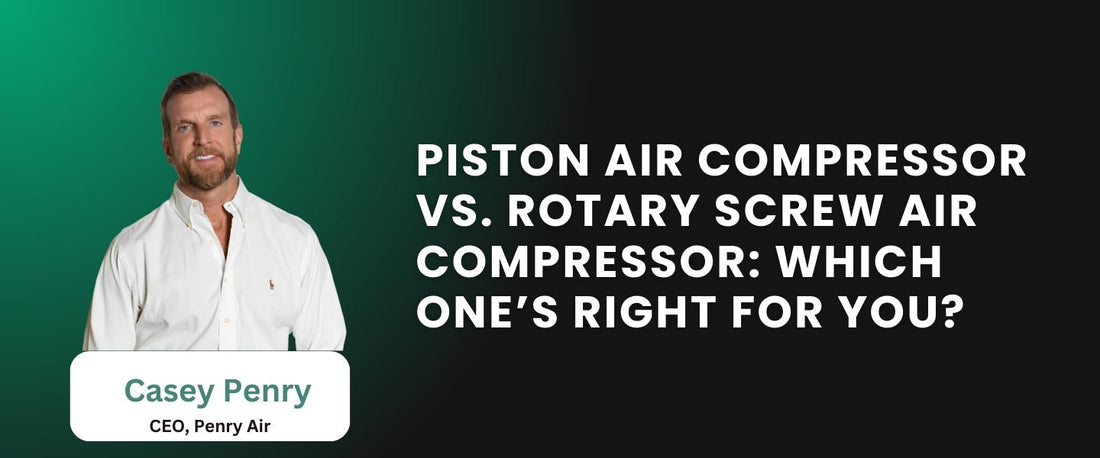Piston Air Compressor vs. Rotary Screw: Which One’s Right for You?

Ah yes, the great showdown: Piston vs. Rotary Screw Air Compressors.
It’s the classic duel in the world of compressed air. Like pickup trucks vs. flatbeds, or manual tools vs. power everything — both have their place, but knowing which one’s right for you can save you time, money, and a few swear words when your compressor can’t keep up.
So if you’ve been wondering whether your garage, shop, or business needs that trusty old piston thumper or a high-tech rotary screw air compressor setup, you’re in the right place.
Let’s break this down in plain English (with a bit of attitude) and determine which machine deserves a spot in your workspace.
First Off — What Are We Even Talking About?
Before we get into the cage match, let’s meet our contenders.
Piston Air Compressor (aka Reciprocating Compressor)
This one’s the old-school, tried-and-true bruiser. Piston compressors use one or more pistons that move up and down (hence "reciprocating") to suck in air, compress it, and store it in the tank. They’re simple, loud, and reliable. Think of it as the diesel truck of the compressor world.
Rotary Screw Compressor
This one’s the smooth operator. Rather of pistons, it uses two interlocking screws (rotors) that spin to compress air. Fewer moving parts, less vibration, and way more efficient over long stretches of use. It’s like switching from a hammer to a nail gun—you’re not going back once you’ve tried it.
Round 1: Performance & Efficiency
Let’s get one thing straight: rotary screw compressors eat piston compressors for breakfast when it comes to continuous use.
Piston Pros:
- Great for intermittent tasks (on-off cycles)
- Delivers higher pressure at lower flow rates
- Ideal for short bursts of power—like filling tires, framing nailers, or brad guns
Rotary Screw Pros:
- Made for continuous, heavy-duty applications
- Higher CFM output = more air, more tools, more work
- More energy efficient over time, especially for commercial/industrial use
If you’re running air tools 6+ hours a day? Go rotary screw. If you’re using air in bursts? Piston’s your guy.
Round 2: Noise & Vibration
Let’s be real: piston compressors aren’t exactly known for their library-level quiet. They rattle, hum, and shake like they just downed four energy drinks. That’s part of their charm... but it’s also kind of exhausting.
Piston:
- Loud—seriously, don’t skip hearing protection
- Vibrates more due to moving pistons
- Needs a sturdy spot (preferably not right next to your desk)
Rotary Screw:
- Much quieter (think: low hum vs. angry growl)
- Minimal vibration = less wear on parts and your ears
- Often used in indoor spaces where noise is a factor
If peace matter (home garages, indoor workshops), rotary screw compressors are a clear winner.
Round 3: Maintenance & Lifespan
Here’s where things get interesting. Piston compressors are simple machines—you can fix most problems with a wrench and a YouTube video. Rotary screws? They’re more sophisticated... but also built to last.
Piston Maintenance:
- Requires frequent oil checks, belt inspections, and air filter replacements
- Shorter duty cycle = needs cooldown time
- Generally lasts 10,000–15,000 hours with proper care
Rotary Screw Maintenance:
- Less frequent maintenance, but requires a bit more expertise
- Built for 100% duty cycles
- Can last 60,000+ hours if treated well
If you’re the DIY fixer-upper type, the piston’s easier to work on. If you prefer minimal hassle and longer lifespan, the rotary screw wins hands down.
Round 4: Cost – Upfront vs. Long-Term
Let’s talk money. Piston compressors are usually cheaper out of the gate, but rotary screws may save you cash long-term—if you’re running them often.
Piston:
- Lower upfront cost
- Higher energy cost per CFM
- Maintenance parts are cheap and easy to find
Rotary Screw:
- Higher initial investment
- Lower operating cost per hour
- Saves money over time in high-usage environments
Budget-conscious and occasional use? Go piston. Running 24/7 production lines? Rotary screw pays for itself.
Round 5: Use Case — What’s It Actually Best For?
Here’s your cheat sheet:
Compressor Type Best For...
Piston Home garages, woodworking shops, mobile mechanics, auto enthusiasts
Rotary Screw Manufacturing, paint booths, CNC shops, commercial auto repair, industrial setups
If you’re operating a tool or two at a time, intermittently, the piston works just fine. But if you’ve got an air-hungry workflow that barely pauses for coffee breaks? Don’t even think twice—go rotary.
Real Talk: Which One Should You Get?
Here’s the no-fluff decision guide:
-
Choose a piston compressor if:
- You’re working on and off throughout the day
- You want something affordable and easy to fix
- You don’t mind a little noise and vibration
- You’re working on DIY, automotive, or light shop tasks
-
Choose a rotary screw compressor if:
- You need continuous airflow with no downtime
- You’re running multiple tools or machines at once
- You care about efficiency, lower noise, and longevity
-
You’re okay spending more upfront for a long-term payoff
Final Thoughts
There’s no one-size-fits-all when it comes to air compressors—just the one that fits you.
- Piston compressors are rugged and simple, and get the job done—especially if you’re not using them around the clock.
- Rotary screw compressors are smooth, efficient powerhouses built for the long haul and nonstop work.
The key is knowing what your tools, your projects, and your workflow actually need.
So take stock of how you use compressed air—and invest in the right machine to back you up. Your tools (and your ears) will thank you.
Choose smart. Stay pressurized. And keep that air flowing.